#ppe detection
Explore tagged Tumblr posts
Text
PPE Detection - AI Video Analytics PPE Monitoring
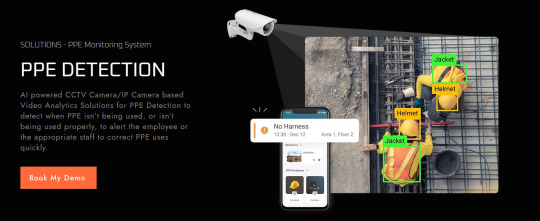
viAct’s AI-powered PPE Detection solution enhances workplace safety by utilizing advanced video analytics to monitor and ensure proper use of personal protective equipment (PPE) in real-time. Integrating seamlessly with existing CCTV or IP camera systems, it detects instances of missing or improperly worn PPE—such as helmets, vests, gloves, and masks—and instantly alerts workers or safety personnel. This proactive approach can prevent up to 95% of fatal injuries caused by PPE non-compliance and reduce compensation costs by 80%. The system is adaptable across various industries, including construction, manufacturing, oil & gas, and mining, offering 24/7 monitoring and compliance reporting. Deployment is straightforward, requiring only three steps: connect existing cameras, process footage through viAct’s AI, and monitor via cloud or edge platforms.
0 notes
Text
How AI-Driven Compliance Monitoring Revolutionizes Workplace Safety
With the increasing complexity of industrial environments and ever-stricter regulations, ensuring workplace safety has become more challenging. Traditional manual safety monitoring methods often fall short in addressing these evolving risks. This is where AI workplace safety systems step in, transforming the way organizations manage and improve their safety protocols.
Real-Time Risk Detection
AI workplace safety systems offer constant real-time monitoring of working environments. Unlike human supervision, AI systems are tireless and capture every crucial detail. Tools like the AI safety camera detect potential hazards such as improper use of personal protective equipment (PPE), trip risks, or dangerous behavior, triggering alerts to prevent accidents before they escalate.
Proactive Safety with Predictive Analytics
The strength of AI for workplace safety lies in its ability to use historical data for predictive analytics. By recognizing patterns in workplace incidents and behaviors, AI helps safety teams to take preventive action before accidents happen. This proactive approach reduces the likelihood of workplace accidents and ensures that safety protocols remain up-to-date.
Minimizing Human Error
Human error is a leading cause of workplace accidents, but AI-driven systems drastically reduce this risk by automating the monitoring process. For example, PPE detection integrated with AI can instantly notify workers or supervisors if protective gear is missing, helping maintain compliance and preventing potential dangers.
Seamless Integration with Existing Systems
AI solutions for workplace safety, such as the AI safety camera, are designed to work with existing infrastructure, allowing businesses to enhance their safety procedures without major investments. By integrating these AI-driven systems, organizations can ensure real-time risk detection without disrupting ongoing operations.
For a deeper dive into how AI-driven compliance monitoring is reshaping workplace safety, explore Visionify’s detailed article.
By adopting AI technology, companies can create safer environments, meet compliance regulations effectively, and reduce incidents, all while improving productivity and efficiency.
0 notes
Text
AI PPE Detection Software

Enhance workplace safety with AI PPE Detection Software. Our advanced PPE tracking system ensures real-time compliance monitoring and reduces risks with automated safety checks.
0 notes
Text

#PPE Detection Market#PPE Detection Market Share#PPE Detection Market Size#PPE Detection Market Research#PPE Detection Industry#What is PPE Detection?
0 notes
Text
Personal Protective Equipment (PPE) Detection Software
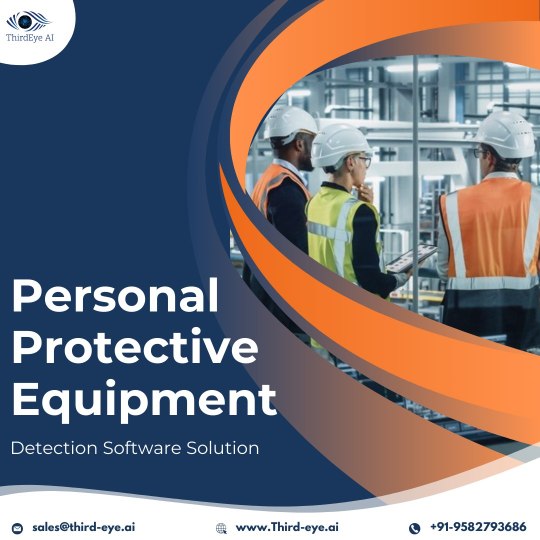
Enhance workplace safety with ThirdEye AI's PPE monitoring software for manufacturing. Our personal protective equipment (PPE) detection technology ensures compliance, alerting on violations and promoting a safer environment. With advanced PPE monitoring solutions, track and manage the usage of safety gear seamlessly, safeguarding your workforce and operations. Experience efficient PPE monitoring for heightened workplace safety.
#PPE monitoring software for manufacturing#PPE detection technology#PPE monitoring software#PPE monitoring solutions#personal protective equipment
0 notes
Text
By Nicolas Hulscher, MPH
The CDC study titled Highly Pathogenic Avian Influenza A(H5N1) Virus Infections in Humans was just published in The New England Journal of Medicine:
BACKGROUND Highly pathogenic avian influenza A(H5N1) viruses have caused widespread infections in dairy cows and poultry in the United States, with sporadic human cases. We describe characteristics of human A(H5N1) cases identified from March through October 2024 in the United States. METHODS We analyzed data from persons with laboratory-confirmed A(H5N1) virus infection using a standardized case-report form linked to laboratory results from the Centers for Disease Control and Prevention influenza A/H5 subtyping kit. RESULTS Of 46 case patients, 20 were exposed to infected poultry, 25 were exposed to infected or presumably infected dairy cows, and 1 had no identified exposure; that patient was hospitalized with nonrespiratory symptoms, and A(H5N1) virus infection was detected through routine surveillance. Among the 45 case patients with animal exposures, the median age was 34 years, and all had mild A(H5N1) illness; none were hospitalized, and none died. A total of 42 patients (93%) had conjunctivitis, 22 (49%) had fever, and 16 (36%) had respiratory symptoms; 15 (33%) had conjunctivitis only. The median duration of illness among 16 patients with available data was 4 days (range, 1 to 8). Most patients (87%) received oseltamivir; oseltamivir was started a median of 2 days after symptom onset. No additional cases were identified among the 97 household contacts of case patients with animal exposures. The types of personal protective equipment (PPE) that were most commonly used by workers exposed to infected animals were gloves (71%), eye protection (60%), and face masks (47%). CONCLUSIONS In the cases identified to date, A(H5N1) viruses generally caused mild illness, mostly conjunctivitis, of short duration, predominantly in U.S. adults exposed to infected animals; most patients received prompt antiviral treatment. No evidence of human-to-human A(H5N1) transmission was identified. PPE use among occupationally exposed persons was suboptimal, which suggests that additional strategies are needed to reduce exposure risk. (Funded by the Centers for Disease Control and Prevention.)
20 notes
·
View notes
Text
On the Scene


RK900 x gn!Detective!Reader
Lt. Hank Anderson and Det. Connor Anderson are on the scene of a grisly murder. They have some investigating to do, and not just into the scene of the homicide that you and Richard were first called to inspect.
A/N: phew! first real post in a while. DBH has a chokehold on me and I have no idea how it happened (I haven't even gotten the game yet—I'm waiting for it to go on sale). That being said, hope this isn't too OOC! I was inspired to write this by the one scene in A Study in Pink from BBC's Sherlock. I messed around with the scene so the dialogue isn't a carbon copy, though.
Yes, I settled on calling Nines Richard (I'm indecisive). Hank calls him Nines as a nickname of sorts.
warnings: implied sexual references, sorely lacking in beta reading
read here on ao3
Cold, damp nights like these were not entirely uncommon in Detroit. If anything, they were a part of the city’s branding.
After all of his years in the God-forsaken city, Lieutenant Hank Anderson knew at least that much.
His CD player blasting heavy metal, he slowed his aging car to a stop on the side of a residential street in a more tasteful stretch of Detroit. Police cruisers and personnel crowded the street already narrowed with cars parked beside the curb on each side. The house in question was cast in the blue and red light of the cruisers’ beacons, an adequate welcome for those who chose to step inside.
Hank eased himself out of the driver’s seat and into the chilly air, groaning as his joints protested. His partner Connor, ever so enthusiastic when it came to work, exited from the other side and followed Hank with quick, precise strides until they reached the yellow holographic police tape set up around the crime scene.
“Hello, Lieutenant, Detective.” The duo was greeted by the stoic face of Richard, the DPD’s RK900 investigator android, who was just about as close to a brother that Connor, the RK800, had. His fair complexion was bathed in the flashing lights of the squad cars and spotlights that had been set up around the scene, but he seemed to pay no mind to the glare.
“Nines.” Hank grunted. “We’re here to see Detective L/N.” Richard raised a perfect brow, his expression set with feigned intrigue.
“Why?” Hank chuckled.
“We were invited, why else?”
“Is that so?” A grin inched its way onto Hank’s grizzled face.
“I think they want us to take a look at some evidence. Think it might be related to our red ice case. That’s why you made the call, didn’t ya?” Richard cracked a small half-smile.
“Right as always, Lieutenant. It seems like your investigative skills have stayed sharp after all these years.” Hank barked out a laugh as he and Connor crossed through the holographic boundary. Just as they passed by the RK900, Hank stopped abruptly, wrinkling his nose.
“Lieutenant?” Connor inquired from beside him.
“It’s nothin’, son.” It didn’t sound like nothing to Connor—not that he voiced that notion, anyways. From behind their turned backs, Richard’s LED flashed red momentarily.
They were making their way up the front porch steps when you appeared in the doorway in your CSI jumpsuit and PPE, fiddling with your gloves.
“Hey, Anderson, so nice of you to finally come.” You greeted the pair with a smile. “Careful with the evidence back there, don’t want to get it contaminated with Sumo’s fur or something. Richard thinks it might be of some help with your red ice case.”
“You didn’t make it home last night, did ‘ya?” The smile disappeared from your face. That wasn’t the response you had been expecting.
“I’m sorry?”
“Tell me, L/N, did ‘ya at least get someone to feed your cats?” He watched your expression, brows raised with skepticism. “C’mon. You can do a little better than hiding that hickey under your PPE.” He gestured loosely at the collar of your jumpsuit. Your hand instinctively went to the bruise that you knew was blooming underneath the fabric.
“What—”
“And you, Nines!” Hank called out to Richard, who was just crossing the front yard to join the conversation.
“Is there something you wanted to tell me, Lieutenant?” Richard’s expression and composure were practically free of tics and tells—one of the benefits of being an android, deviant or not, Hank supposed. Richard tilted his head with bemusement.
“Oh, don’t play dumb. Say, are ‘ya trying out some new scent for androids? Smells a lot like L/N’s deodorant if you ask me.”
“Y/N and I spent the night at the precinct,” Richard answered quickly. “We were looking over evidence early this morning when the homicide was called in. They offered me their coat when it began to rain because—”
“Yeah, ‘cause androids don’t like getting their clothes wet after just getting ‘em from the Cyberlife dry cleaners,” he drawled. “Funny that the knees of your slacks are so banged up, Nines. Maybe you should bring ‘em back.”
“Hank, whatever you’re trying to imply—”
“I know, kid, I know. Also, you two are on a first name basis now? Geez, did I miss something while I was on holiday?”
“Hank...” Your voice dripped with exasperation. “Just inspect the damn crime scene, will you?”
“Alright, alright,” Hank waved you off and stepped into the house. “But I’m expecting a wedding invitation by next spring, y’hear?”
~~~~~~~~~~~~~~~~~~~~~~~~~~~~~~~~~~~~~~~~~~~~~~~~~~~~~~~~~~~~~~
[A/N]: So, yeah, I don't know jack about DBH or BBC's Sherlock...well, reading the BBC's Sherlock manga counts as interacting with the source material, right?
Hope you enjoyed! Thanks for reading x
#detroit become human#detroit become human x reader#rk900 x reader#dbh x reader#dbh rk900#dbh nines x reader
127 notes
·
View notes
Text
Computer Vision for PPE Compliance: A New Era of Workplace Safety
Unlock a safer workplace with our latest blog on Computer Vision for PPE Compliance. Discover how cutting-edge computer vision technology is revolutionizing PPE detection, ensuring compliance, and enhancing workplace safety.
0 notes
Text
How AI-Driven Compliance Monitoring Enhances Workplace Safety
In today's rapidly evolving industrial environments, ensuring workplace safety is becoming more challenging as businesses face increasing regulations and compliance standards. Traditional manual monitoring methods are no longer enough to keep up with these changes. That’s where AI-driven compliance monitoring comes in, transforming how companies manage and improve safety.
Real-Time Hazard Detection
AI workplace safety systems are now capable of analyzing environments in real time, providing continuous monitoring for potential safety risks. Unlike human oversight, AI never tires or overlooks details, making it a more reliable solution. Using tools like an AI safety camera, these systems can detect hazards such as non-compliance with personal protective equipment (PPE), trip-and-fall risks, or dangerous behavior on the job.
Predictive Analytics for Proactive Safety Management
One of the most powerful advantages of AI for workplace safety is its ability to use predictive analytics. By analyzing historical safety data and patterns of worker behavior, AI systems can anticipate potential risks, allowing safety teams to take preventative measures before incidents occur. This proactive approach ensures that workplace accidents are minimized, and safety protocols are enhanced continuously.
Reducing Human Error
A significant portion of workplace accidents is due to human error. AI-driven systems dramatically reduce this risk by automating safety monitoring and offering real-time interventions. For example, PPE detection systems integrated with AI can immediately notify workers and supervisors if an employee is not wearing the appropriate protective gear, thus preventing potential accidents and ensuring compliance with safety standards.
Seamless Integration with Existing Systems
AI-driven solutions for workplace safety can integrate seamlessly with existing camera infrastructure, allowing businesses to upgrade their safety protocols without large-scale investments. By incorporating AI safety camera systems, companies can monitor their environments more effectively while ensuring their operations run smoothly and efficiently.
For further details on how AI-driven compliance monitoring enhances workplace safety, explore the full insights in Visionify's article.
By adopting advanced AI systems, businesses can create safer work environments, ensure regulatory compliance, and reduce risks, all while enhancing productivity and efficiency.
0 notes
Text
H5N1: What to know before fear spreads
What is H5N1?
H5N1 is a 1996 strain of the Spanish or Avian Flu first detected in Chinese birds before spreading globally across various avian species. H5N1 is similar to H1N1, but spreads slower and has a much higher mortality rate.
H5N1 may also be referred to as Influenza A. The American Association of Bovine Practitioners has seen fit to rename H5N1 to Bovine Influenza A Virus, or BIAV, and are encouraging others to use the same terminology.
I would not be surprised if the colloquial name among the public becomes Bovine Flu or American Flu in the coming months, and may be referred to as the Chinese Flu by the same folks who took the spark of the SARS-CoV-2 (COVID-19) pandemic as an excuse to be publicly racist to East Asian people without social repercussions.
BIAV is a virus, meaning that it is a (probably) non-living packet of self-replicating infectious material with a high rate of mutation. BIAV is structured similarly to SARS-CoV-2, having a packet of infectious material encased in a spherical shell with a corona, or crown, of proteins that can latch to living cells to inject RNA.
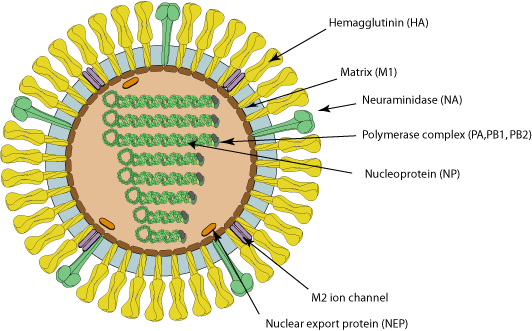
Image source with interactive model: ViralZone - H5N1 subtype
What is the history of BIAV?
In 1996 and 1997, an outbreak of BIAV occurred among poultry and infected 18 people in Hong Kong, 6 of which died. This seemingly isolated incident then infected ~860 people with a >50% death rate.
At the time, BIAV was known as Highly Pathogenic Avian Influenza, or HPAI, and killed nearly 100% of chickens within a 48 hour period.
From 2003 to 2005, continual outbreaks occurred in China and other East Asian countries, before spreading to Cambodia, the Netherlands, Thailand, and Vietnam.
From 2014 to 2016, it began being detected in American fowl, as well as mutating the H5N6 (lethal in birds, no human to human transmission) and H5N8 (largely spread through turkeys, ducks had immunity) viruses.
BIAV has since evolved into a clade known as 2.3.4.4b, and was first detected in 2021 in wild American birds. This then caused outbreaks in 2022 among wild and domesticated birds (such as chickens) alike, but was largely being overshadowed by the pressing SARS-CoV-2 pandemic at the time.
From 2022 to 2023, it was observed to be spreading among various mammals, including humans. Now, in 2024, we're having the most concerning rapid outbreak of BIAV since 2003.
BIAV is known to spread from mammal to mammal, particularly between cows and humans. BIAV may also be spread from cow to cow (highly likely, but not confirmed - this is likely the reason the virus has spread to Idaho from Texan cattle), and is known to be lethal to domestic cats and birds within 48 hours.
How does BIAV spread?
BIAV spreads through fomites - direct contact with infected animals or infected surfaces and then touching parts of your face or other orifices - as well as through airborne particulates, which may be inhaled and enter the sinuses and lungs.
BIAV is known to spread through:
Asymptomatic Ducks, geese, swans, various shorebirds
Symptomatic, may be lethal Foxes, bears, seals, sea lions, polar bears, domestic cats, dogs, minks, goats, cows, (potentially human to human, but unconfirmed - there have only been 8 potential human to human cases in 2024).
How can I protect against BIAV?
As BIAV is a type of Influenza A, existing protocols should do fine.
Current recommendations are to wash your hands vigorously after interacting with birds (I would also recommend doing this with mammals), avoid touching your face or other open orifices, and wear N95 masks.
Avoid sick or dead animals entirely - I would also recommend reporting them to your local Animal Control or veterinary centre and warning them about the infection risk. People who work with animals are recommended to also wear full PPE such as N95 masks, eye protection, gloves, and partake in vigorous hand washing.
If you suspect you've caught BIAV, seek medical attention immediately. Existing medications such as oseltamivir phosphate, zanamivir, peramivir, and baloxavir marboxil can reduce BIAV's ability to replicate.
Standard flu shots will not protect against BIAV. Remember - symptoms of BIAV may not manifest for between 2 to 8 days, and potentially infected people should be monitored for at least 10 days.
How far has BIAV spread?
BIAV is currently a global virus, though the current infection location of note is the United States.
Image Key: Dark red - Countries with humans, poultry and wild birds killed by H5N1 Deep red - Countries with poultry or wild birds killed by H5N1 and has reported human cases of H5N1 Light red - Countries with poultry or wild birds killed by H5N1
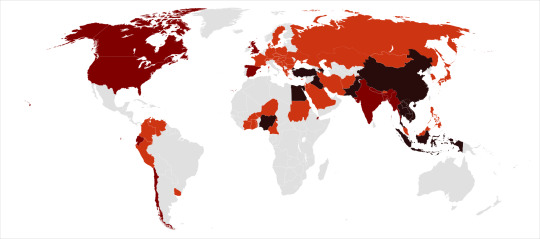
Image source: Wikipedia - Influenza A virus subtype H5N1 - File: Global spread of H5N1 map
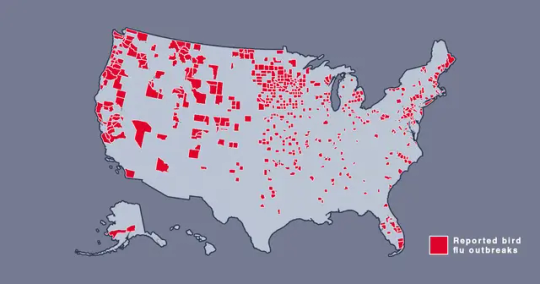
Image source: Metro.co.uk - Map shows where bird flu is spreading in US amid new warning - File: The Centers for Disease Control and Prevention’s H5N1 bird flu detections map across the United States
Should I be afraid?
You needn't be afraid, just prepared. BIAV has a concerningly high lethality, but this ironically culls its spread somewhat.
In the event human to human transmission of BIAV is confirmed, this will likely mainly affect marginalized communities, poor people, and homeless people, who are likely to have less access to medical care, and a higher likelihood of working in jobs that require frequent close human contact, such as fast food or retail jobs.
Given the response to SARS-CoV-2, corporations - and probably the government - may shove a proper response under the rug and refuse to participate in a full quarantine, which may leave people forced to go to work in dangerous conditions.
If this does spread into an epidemic or pandemic, given our extensive knowledge about Influenza, and the US having a backup vaccine for a prior strain of H5N1, a vaccine should be able to be developed relatively quickly and would hopefully be deployed freely without charge - we won't have to worry about a situation like The Stand.
Wash your hands, keep clean, avoid large social gatherings where possible, wear an N95 mask if you can afford them (Remember: Cloth masks are the least protective, but are better than nothing. If you can't afford N95 masks, I recommend wearing a well-fitted cloth mask with a disposable face mask over it to prevent pneumonia from moisture buildup in the disposable mask), support the disabled, poor, and homeless, and stay educated.
We can do better this time.
Further things to check out:
YouTube: MedCram - H5N1 Cattle Outbreak: Background and Currently Known Facts (ft. Roger Seheult, M.D.)
Wikipedia - Influenza A virus subtype H5N1
Maine.gov - Avian Influenza and People
CDC.gov - Technical Report: Highly Pathogenic Avian Influenza A(H5N1) Viruses
Wikipedia - H5N1 genetic structure
realagriculture - Influenza infection in cattle gets new name: Bovine Influenza A Virus (BIAV)
#H5N1#bird flu#avian flu#bovine flu#BIAV#pandemic#epidemic#COVID 19#coronavirus#spanish flu#long post#text post#no id#undescribed#news#politics#us news#us politics#american news#american politics#world news#global news#global politics#world politics#lgbt#lgbtq#queer#trans#communist#socialist
58 notes
·
View notes
Text
Sins carved into bone


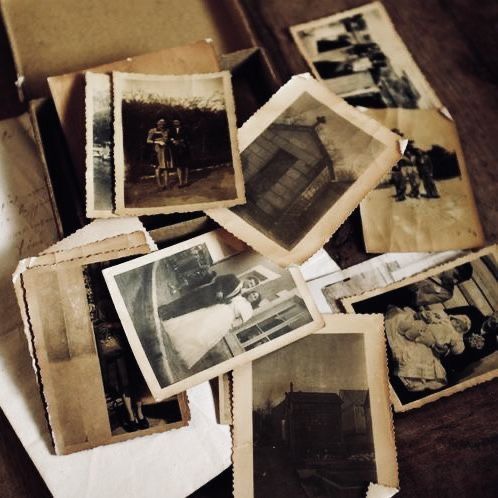
Sweet mourning lamb Ch 2
Warnings: Gore, Death, hinted SA. prob more idk chapter 2 song:
There’s a girl. A young girl, on her knees facing the altar as if she was praying. She’s naked, one ankle crossed over the other and bound with red string. Her hands tied around a wooden cross, elbows propped to hold her upright against the altar. Her long black hair flowing along her bare back. This was a ritual. The thought floods my mind almost like an instinct.
“Good Morning West” I hear the Captain say in a low tone . I turn left to face him “Good Morning Captain, what do we know?’ I answer. “Dispatch received the call around 3 this morning” He starts. “Couple of kids broke in and saw the body, they ran home to their parents and told them.” “So far we know the murder didn’t take place here.” “There’s lividity along her back so she was placed here post mortem” He points to her. I begin to approach the body walking towards her left side. I crouch down to get a better look. “CSI get all their pictures?” I ask before investigating. “They did.” Captain assures. I pull the glove from my jacket pocket and pull it over my hand. I move her black hair and place it behind her ear. Poorly placed stitches line her sewn eyes. The same thing was done to her mouth. I look farther down and cock my head at the sight. “What do you think could cause this?” I say motioning towards her swollen and lumped abdomen. “Luckily there’s someone with a medical license to tell us that” I turn to face the source of the response heard from behind me. I stand up in front of the tall man. “West this is Detective Loki, Loki this is West” Captain says with sarcasm and frustration. “I know who he is” I say while turning back to the body. Detective Loki, arguably one of the best detectives in the department. We’ve both held places for detective of the year since I arrived. Ironically we’ve never worked a case together. That’s all the information I have on Loki. Loki is a lone wolf type. No known friends or family, spends most if not all of his time at the office, and rarely feels the need to be cordial. I ignore his presence and continue. “There’s bruising around the eyes and mouth, these injuries happened while she was still alive.” I say jotting the evidence down in a notebook. “Let’s get the body to the medical examiner as quickly as possible please, I need to know more” I say to the officer across the altar. The officer nods and ushers the men in ppe’s towards the body. I stand to face the captain. “So…?” Captain asks. “This was definitely a ritual of some kind, I’ll do some research, but this seems independent. This has religious undercurrents, but this seems like a personal fantasy not something done by the book” I say crossing my arms. “I’m with you on that” The captain agrees. Loki is characteristically silent. He stares at her. An unintelligible look on his face. “Any ideas David?” Captain asks Loki. “She meant something to him.” he says, still staring at the girl. “I can’t imagine he’d perform a ritual on something he saw no meaning in.” I say, annoyed at his observation. He turns his head slowly to meet my eyes. “Romantic.” He says roughly. “She had a romantic meaning to him.” he adds. “How do you figure?” Captain responds quizzically. “To us this looks grotesque and ugly, but to him this is something else.” Loki starts. “Her hair is neat, possibly brushed. No other signs of violence on her body. She’s clean and perfumed. No signs of late decomposition. He made her look “attractive” in his own way” he says. “How does that signal romance?” I retort “Most sacrifices require a clean and decorated object, like the fattest livestock or most prized possession, it doesn’t qualify as a sacrifice if it's invaluable. I finished. “You’re looking through the wrong lens.” he says like it’s a known and proven fact. “I’m looking through the lens of 10 years of experience and a degree in criminal psychology” I responded. His arrogance is biting at my professionalism. “She wasn’t being sacrificed, this is ceremonial. It’s her memorial.” He says.
My eyebrows furrow together and my head pulls back. I turn and make eye contact with Loki. I shake my head and turn back towards the large wooden doors. I consider his point for a moment. He was right. This was done for her, not to her. Whatever came before this was the real deed. This was his way of cleaning up after the ritual, not the ritual itself. I take the hint that me and Loki are assigned to this case as a pair. I decided then and there I’d swallow my pride and admit his accuracy. I walk back towards him. “Let’s get some ID on her and get some interviews on the kids who found her,” I say to him. “We’ll wait for the autopsy report and go from there”. I add. “Yeah” he says quickly and leaves towards the doors. I start to regret swallowing my pride as it rises back up. “ Arrogant prick.” I whisper.
#david loki x reader#jake gyllenhaal x reader#jake gyllenhaal#southern gothic#ethel cain#enemies to lovers#prisoners#Spotify
9 notes
·
View notes
Text
Also preserved on our archive (That's right: It's more than just covid!)
Centers for Disease Control and Prevention (CDC) has confirmed two human cases of H5 bird flu from specimens submitted by California. The cases occurred in people with occupational exposure to infected dairy cows. An investigation led by California is ongoing. The identification of H5 in people with exposure to infected animals is not unexpected and does not change CDC's risk assessment for the general public, which continues to be low.
At this time, there is no known link or contact between the first and second confirmed cases in California, suggesting these are separate instances of animal-to-human spread of the virus. CDC continues to collaborate closely with California and other state public health officials to support state-run efforts to control the spread of H5N1 from infected animals to humans; California's active monitoring highlights the steps being taken at the state level to lower the risk to farm workers who may be in contact with animals with H5N1. In the coming days, CDC will conduct additional characterization of the viruses, including sequencing, isolating and growing the viruses, if possible.
These are the first human cases of H5 in California, where H5N1 outbreaks among dairy herds were first reported in August 2024. H5N1 bird flu was detected for the first time in cows this year in the United States. The virus is widespread in wild birds and has caused ongoing outbreaks among poultry in the United States since 2022. It has caused rare, sporadic infections in people who work with infected animals, such as dairy cow workers and poultry workers. Including this most recent case, 16 human cases of H5 have been reported in the United States during 2024, bringing the total to 17 cases since 2022. Six of the 16 reported human cases have been linked to exposure to sick or infected dairy cows.Nine cases had exposure to infected poultry.
CDC has recommendations to protect people against H5N1 bird flu in dairy cattle. These include avoiding contact with wild birds and sick or dead animals and not preparing or eating unpasteurized (raw) milk or raw cheese. If you work with dairy cows or other animals that could be infected with H5N1 bird flu, wear personal protective equipment (PPE) when in contact with (or around) dairy cows, raw milk, other animals, or surfaces and other items that might be contaminated with virus. CDC recently issued updated personal protective equipment guidance (PPE) to prevent H5N1 bird flu infection.
CDC recommends that if you get sick after close contact with infected animals, contact your local health department and a health care provider for testing. Symptoms of H5 include eye redness (conjunctivitis), mild flu-like upper respiratory symptoms, fever, cough, sore throat, difficulty breathing, runny or stuffy nose, and muscle aches.
#Bird flu#avian influenza#H5N1#California#public health#mask up#wear a mask#wear a respirator#still coviding
10 notes
·
View notes
Text

#PPE Detection Market#PPE Detection Market Share#PPE Detection Market Size#PPE Detection Market Research#PPE Detection Industry#What is PPE Detection?
0 notes
Text

Radiation Safety
Safety training for radioactive materials depends on the type of radiation one expects to be exposed to, as well as the amount and duration. Laboratories that deal with radioactive materials must include the appropriate warning signage and sensors to detect radiation, as it cannot be felt by individuals. These sensors can range from permanent, active detectors that will provide an immediate alert to portable instruments. PPE for individuals that work with higher levels of radiation can include a dosimeter, which monitors their individual exposure.
Sources/Further Reading: (Image source - Harvard) (NIH) (University of Wisconsin Milwaukee) (Stanford)
16 notes
·
View notes
Text
How to Extend the Life of Your Electrical Switchgear

Electrical switchgear is a critical component in power distribution systems, responsible for controlling, protecting, and isolating electrical equipment. Whether used in industrial plants, commercial buildings, or utility substations, switchgear must operate reliably to prevent costly downtime, equipment damage, or safety hazards. As such, extending the life of your switchgear is both an economic and operational imperative.
This article outlines essential strategies, best practices, and maintenance procedures that can significantly enhance the longevity and performance of your electrical switchgear.
1. Understand the Role and Types of Switchgear
Before diving into maintenance and care strategies, it’s important to understand what switchgear is and its various types:
· Low-voltage (LV) switchgear: Used for systems below 1,000 volts, common in commercial and residential buildings.
· Medium-voltage (MV) switchgear: Used in systems from 1 kV to 36 kV, typical in industrial and utility distribution networks.
· High-voltage (HV) switchgear: For voltages above 36 kV, used in power transmission infrastructure.
Each type has different components, such as circuit breakers, fuses, relays, and disconnect switches, which require tailored care.
2. Implement a Preventive Maintenance Schedule
Preventive maintenance is the cornerstone of extending switchgear life. Scheduled inspections and servicing can prevent small issues from becoming major failures.
Key preventive maintenance steps include:
· Visual Inspections: Check for signs of wear, corrosion, overheating, or arcing.
· Thermal Imaging: Detect hotspots caused by loose connections or overloading.
· Cleaning: Remove dust, dirt, and moisture using appropriate cleaning agents and methods.
· Mechanical Checks: Operate switches and breakers manually to ensure they move freely and reset properly.
· Lubrication: Apply the correct lubricants to moving parts to prevent wear.
· Electrical Testing: Conduct insulation resistance tests, contact resistance tests, and functionality tests on protection relays.
Frequency:
· Monthly or quarterly: Visual inspections and thermal scanning.
· Annually: Comprehensive testing, cleaning, and mechanical servicing.
3. Upgrade Components and Retrofit When Necessary
As equipment ages, its performance naturally declines. Rather than replacing the entire system, consider retrofitting critical components such as:
· Circuit breakers (replace air-magnetic with vacuum or SF₆ types)
· Protection relays (upgrade to digital, microprocessor-based units)
· Monitoring systems (add condition-monitoring sensors for real-time data)
Modern retrofitting extends service life, improves reliability, and enhances safety without the cost and disruption of full replacement.
4. Maintain Optimal Environmental Conditions
Environmental factors can greatly affect switchgear performance and durability. Control conditions around the equipment by:
· Maintaining Proper Ventilation: Prevent heat buildup with adequate airflow or HVAC systems.
· Controlling Humidity: High moisture levels can lead to insulation breakdown and corrosion.
· Dust and Contaminant Management: Install enclosures with appropriate IP ratings and regularly clean surroundings.
· Avoiding Vibration and Shock: Secure equipment on stable platforms and use vibration dampers if necessary.
5. Train Personnel and Enforce Safe Operating Procedures
Human error is a major cause of switchgear failure. Properly trained staff who understand how to operate and maintain switchgear will significantly reduce risks.
Key practices include:
· Following lockout/tagout (LOTO) procedures
· Using insulated tools and personal protective equipment (PPE)
· Understanding equipment ratings and not exceeding operational limits
· Reporting anomalies immediately
Regular training programs and refresher courses should be a part of your electrical safety culture.
6. Implement Condition-Based Monitoring (CBM)
Moving from traditional preventive maintenance to condition-based monitoring (CBM) can improve accuracy and reduce unnecessary downtime.
CBM Tools Include:
· Partial Discharge Monitoring: Detects insulation degradation early
· Temperature Sensors: Identifies abnormal heating patterns
· Gas Detection: Monitors SF₆ gas quality in HV switchgear
· Remote Diagnostics: Allows offsite engineers to assess equipment in real time
CBM extends switchgear life by ensuring maintenance is performed only when needed — based on actual conditions rather than time intervals.
7. Document Maintenance History and Perform Asset Tracking
Maintain detailed records of all inspections, maintenance activities, upgrades, and failures. This helps in:
· Identifying recurring problems
· Planning timely interventions
· Estimating remaining useful life (RUL)
· Complying with industry regulations and audits
Use asset management software or computerized maintenance management systems (CMMS) to streamline documentation and data analysis.
8. Plan for End-of-Life (EOL) and Decommissioning
Despite all efforts, switchgear eventually reaches the end of its operational life. Having an EOL strategy helps to:
· Prevent catastrophic failure
· Schedule replacements during planned downtime
· Upgrade to systems with modern safety, efficiency, and smart-grid features
Signs that switchgear is reaching EOL include frequent failures, obsolete parts, and loss of manufacturer support.
Conclusion
Electrical switchgear plays a vital role in ensuring the safe and efficient operation of electrical systems. By implementing proactive maintenance, upgrading aging components, monitoring environmental conditions, training personnel, and embracing modern monitoring technologies, you can significantly extend the life of your switchgear.
Not only will these strategies help in maximizing return on investment, but they will also improve safety, reduce downtime, and ensure regulatory compliance. Taking a systematic and well-documented approach to switchgear care is the smartest way to ensure long-term performance and reliability.
6 notes
·
View notes